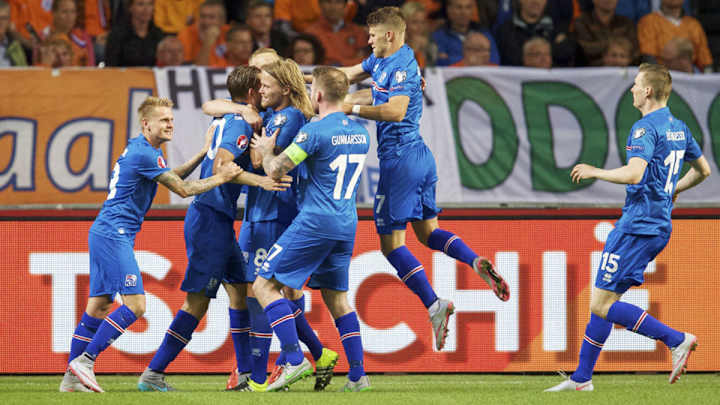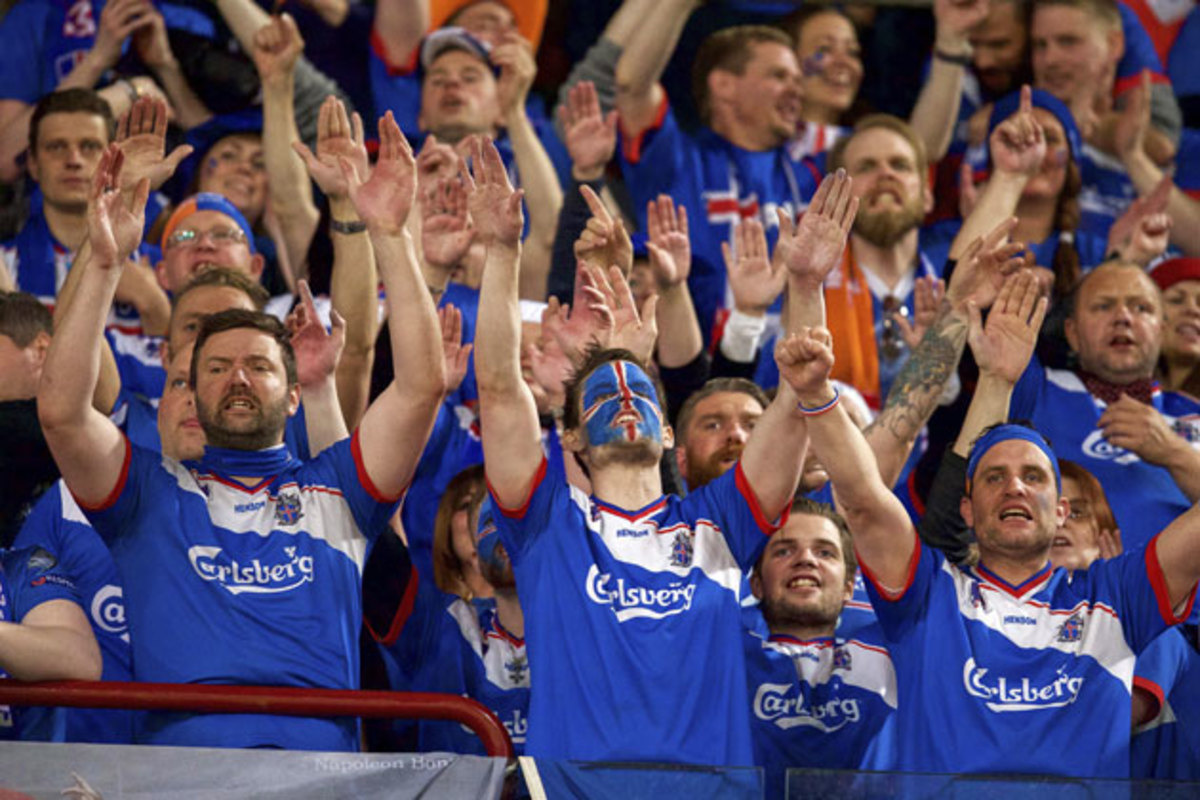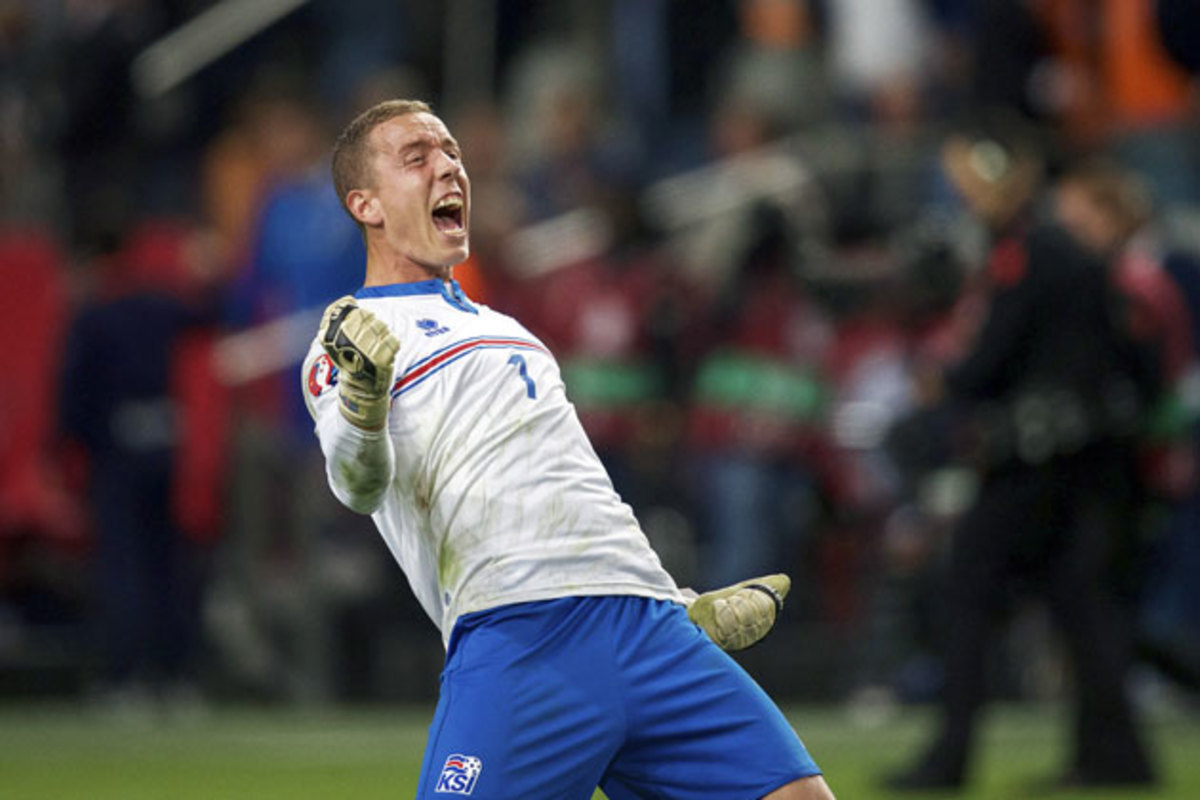Iceland's place at Euro 2016 a result of calculated development, growth

Iceland's ascent as a footballing nation, falling at the final hurdle of 2014 World Cup qualification before become one of the first to qualify for Euro 2016, has been one of the big surprises in recent years. However, looking at the infrastructure the tiny island nation has built, it seems like less of a mystery and more of an inevitability.
Despite an average daily temperature hovering around freezing for nearly half the year, Iceland has been slowly creeping toward the upper echelons of European football since the new millennium. Seven of the squad that pulled off a historic double against the Netherlands, winning 1-0 away from home on Sept. 3 after a 2-0 victory in Reykjavík in October, also qualified for the 2011 UEFA Under-21 Championship.
Those players, now in the prime of their careers, represent the first generation to benefit from a new system of player development. A combination of excellent facilities and a legion of qualified coaches, along with the country’s size making it easier to mobilize all assets, have seen the nation of 330,000 inhabitants climb 89 places in the FIFA world ranking in five years.
Around Europe: Expanded Euro field making for spirited qualifying
As the result of a federation initiative in partnership with local authorities that began in 2002, seven full-sized and four half-sized indoor soccer fields have been built, along with 22 outdoor turf fields and 111 smaller pitches. FIFA also kicked in $2 million between 2004 and 2013, allowing players of all ages to take the field three or four times a week regardless of season.
All the new indoor fields are publicly owned, meaning access is much easier than in comparable facilities that are privately financed and carry steep rental charges.
“Fifteen years ago, football wasn’t really a full-year sport in Iceland,” Arnar Bill Gunnarsson, national technical director and head of coaching education, told SI.com in a phone interview this week. “When I was playing, for example, I used to play handball and basketball during the winter and football during the summer, and I would maybe get one football practice per week in a small basketball hall.”
Around the same time as the facilities initiatives, the Football Association of Iceland (Knattspyrnusamband Íslands, or KSÍ) began hosting UEFA A and B license courses, giving local coaches opportunity to earn the highest qualifications in Europe. In 2013, 447 coaches completed the B course, while 185 received their A license.
“When you start playing football in Iceland … it’s very likely that your coach will have at least a B license—many of them have an A license—and also a PE degree from the university,” Gunnarsson said. “So you get a very highly qualified coach from Day 1, and such a quality coach should be able to make the training session fun, interesting and that means the kids learn to love the game.”
Mailbag: USMNT vs. Mexico, Jurgen Klinsmann, Iceland, Gedion Zelalem
Iceland’s size also works to its advantage in coaching education. Every course is held at the FA headquarters in Reykjavík, and the federation doesn’t try to make a profit on them, keeping costs down for participants. With that philosophy, it’s easy to ensure that every team has a qualified coach. Every coach in Iceland is paid, compared to the hordes of parent-volunteer coaches in countries such as the United States, although few make a full-time living doing it.
It’s frequently a second job or after-school activity for college-aged former players.
While American youth coaches frequently have three or more teams at the same time, their Icelandic counterparts rarely take more than one or two, keeping their attention on a smaller number of players and ensuring those players’ participation is a positive experience.
“When you learn to love the game, then you go out and do some extra,” Gunnarsson said. “Then you go out and play football outside training sessions, and that’s what makes you a better footballer.”

With its results in most recent major tournaments, Iceland has done spectacularly while remaining frugal. Any prize money from next summer’s European Championship will go toward further professionalization of the national team programs. Participating teams get €12 million from UEFA just for being there, as well as bonuses for wins and advancing to the knockout rounds.
Icelandic youth national teams travel short-staffed—they just recently began taking goalkeeper coaches to away matches—because of the cost of flying to and from the mainland. Not even the top league in Iceland is fully professional. Most players in the Úrvalsdeild have second jobs, and the season only runs from May to September.
The stadiums don’t hold enough spectators (national stadium Laugardalsvöllur in Reykjavík has a capacity of 9,800) and the level of play isn’t high enough to attract massive sponsorship money as in Europe’s top leagues, leaving clubs to make money in other ways while paying small wages.
USA must turn it around in time for judgment day next month vs. Mexico
Young Icelandic players have become attractive signings in part because they come cheap. Swansea midfielder Gylfi Sigurðsson joined Reading at age 16, and captain Aron Gunnarsson, now at Cardiff City, signed with AZ Alkmaar in the Netherlands at 17.
All but Breiðablik teammates Gunnleifur Gunnleifsson and Kristinn Jónsson play abroad among the national teamers.
“They really put a lot of emphasis on developing guys and selling guys,” said Joe Funicello, who played two stints for Þór (Thór) Akureyri and runs a company called SoccerViza that places American players abroad, with Iceland a popular destination. “Every day, the kids are in [training]. Right after school, they’re in and they’re there until about 8 o’clock.”
Many who make it to the senior level go through the youth national teams first. Player identification is, again, made easier by Iceland’s small size.
“It’s pretty easy. We already start when they’re 13 years old, and we don’t miss any players,” Gunnarsson said. “Of course, it could happen here, as everywhere else, that some talented player who is small, we’ll miss out on him, but we know of every player who is good in football because of the size of the country and how few we are.”

Goalkeeper Hannes Halldórsson is one who was not identified until the senior level. In his day job as a filmmaker, he directed the video for his country’s Eurovision entry in 2012 while playing for 26-time Icelandic champion Knattspyrnufélag Reykjavíkur (KR), the oldest and most successful club in the country.
KR’s 2011 title sent the team to the 2012-13 Champions League second qualifying round, where Halldórsson was in goal for a 9-1 aggregate loss to HJK Helsinki. (Stjarnan made Iceland’s most successful recent European run, advancing all the way to the Europa League playoffs last season, beating Motherwell and Lech Poznań before falling to Inter Milan.) Halldórsson has since moved on to NEC in the Dutch Eredivisie, making the jump to full-time professional soccer.
Despite its centralized system, the Icelandic federation doesn’t pursue homogeneity in player development. Clubs are free to follow their own philosophy on style of play, and many have entrenched traditions and history that are maintained. It would also be difficult to fully embrace one style or specific formation because with the size of the talent pool, not every age group will have capable players at every position.
“The clubs are very independent, and the clubs really make players for us, for the national team, of course. Each club has its own identity, but it’s football—it isn’t that different between the clubs. All the coaches have the same education. I think most of the kids are having the same basic training,” Gunnarsson said. “We’re not really interested in having everyone playing the same style of football, but there are things that we have to be better at: We’re pretty good at defending, and our mentality makes [for] great team spirit, but we need to be better at things like keeping possession.”
As playoffs near, can NWSL take steps forward with World Cup momentum?
The most obvious qualities of Icelandic players have historically been that mentality and work ethic—“It’s engraved in their culture: work hard, work hard, work hard,” Funicello said—but teams can’t win on spirit alone at the top levels.
Iceland’s technical quality, spurred on by its grassroots initiatives, has spiked since the current internationals turned pro.
“It’s difficult to play against us, and we’ve always done that. We’ve always had a good mentality,” Gunnarsson said, “but now, we also have more technical ability than we used to.”
With Iceland rapidly on the rise in UEFA, the team should only continue breaking barriers in subsequent competitions. The model appears to be sustainable; the current U-21s defeated France, 3-2, two days after the senior team beat the Netherlands.
Of course, it’s easy to make grand prognostications in the midst of a golden generation.
“The core of the team, the strongest players, are at a good age now,” Gunnarsson said, “so I think the team will be pretty strong for a few years at least, but it’s very difficult to say if the players coming up are good enough. You never know.”
However, if the cultural shift toward soccer in Iceland continues, it might not be long before the island nation turns into Europe’s version of Uruguay, a country that consistently outperforms expectations despite its tiny population.
“Since I was there in 2010 and went back in 2013, in those two years, it’s gotten better,” Funicello said. “They love the game—that and handball are the two main sports there, and football is really starting to just surpass handball. I definitely see the future being bright.”
